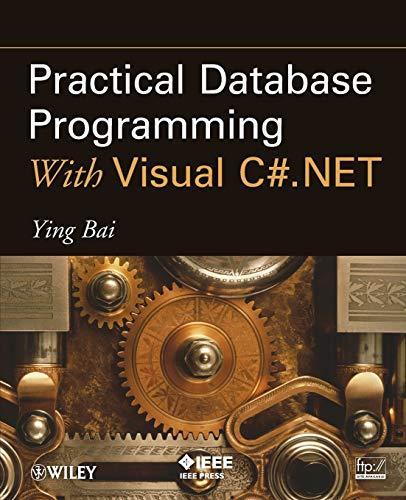Question
(1 point) This question concerns block cipher modes. We will use a simple affine cipher, which can be expressed in C as follows. char cipher(unsigned


(1 point) This question concerns block cipher modes. We will use a simple affine cipher, which can be expressed in C as follows.
char cipher(unsigned char block, char key) { return (key+11*block)%256; }
Note that the block size is 8 bits, which is one byte (and one ASCII character). We will work with the fixed key 0x08.
We now encrypt various plaintexts using modes for this cipher. In every case in which the mode requires an IV, the IV will be 0xAA. In the case of CTR mode, we use a (nonce || counter) arrangement in which the nonce is the left 5 bits of 0xAA and the counter is a 3 bit counter that begins at 0. In all of the problems given below, one character is one block. Each character of the plaintext should be regarded as its corresponding ASCII code.
a) Encrypt the plaintext "" using mode. Please enter your answer in hex. (Please do **not** enter an 0x, as this has been done.) 0x ______________
b) Encrypt the plaintext "" using mode. Please enter your answer in hex. 0x _______________
c) Encrypt the plaintext "" using mode. Please enter your answer in hex. 0x ________________
d) Encrypt the plaintext "" using mode. Please enter your answer in hex. 0x _________________
e) Encrypt the plaintext "r" using mode. Please enter your answer in hex. 0x __________________
Chapter5: Problem 1 Previous Problem Problem List Next Problem point) This question concerns block cipher modes. We will use a simple affine cipher, which can be expressed in C as follows. char cipher(unsigned char block, char key) { return (key+11*block)%256; } Note that the block size is 8 bits, which is one byte (and one ASCII character). We will work with the fixed key Ox08. We now encrypt various plaintexts using modes for this cipher. In every case in which the mode requires an IV, the IV will be OxAA. In the case of CTR mode, we use a (nonce || counter) arrangement in which the nonce is the left 5 bits of OxAA and the counter is a 3 bit counter that begins at 0. In all of the problems given below, one character is one block. Each character of the plaintext should be regarded as its corresponding ASCII code. a) Encrypt the plaintext "blotto" using CTR mode. Please enter your answer in hex. (Please do **not** enter an Ox, as this has been done.) Ox b) Encrypt the plaintext "blind" using ECB mode. Please enter your answer in hex. Ox c) Encrypt the plaintext "rango" using CFB mode. Please enter your answer in hex. Ox d) Encrypt the plaintext "rind" using CBC mode. Please enter your answer in hex. Ox e) Encrypt the plaintext "pepper" using OFB mode. Please enter your answer in hex. OxStep by Step Solution
There are 3 Steps involved in it
Step: 1

Get Instant Access to Expert-Tailored Solutions
See step-by-step solutions with expert insights and AI powered tools for academic success
Step: 2

Step: 3

Ace Your Homework with AI
Get the answers you need in no time with our AI-driven, step-by-step assistance
Get Started


